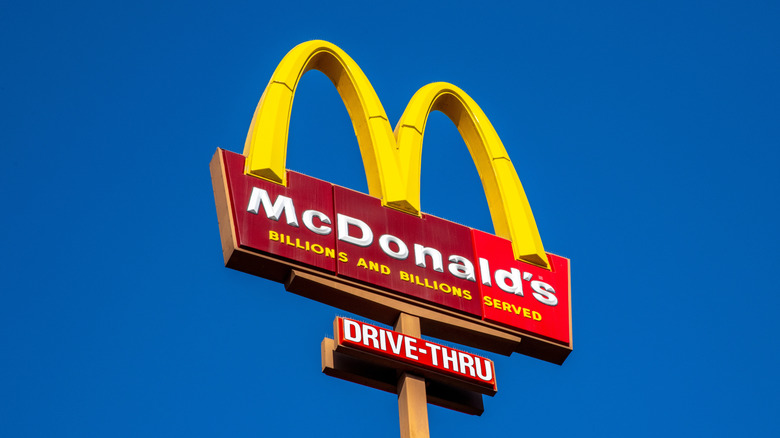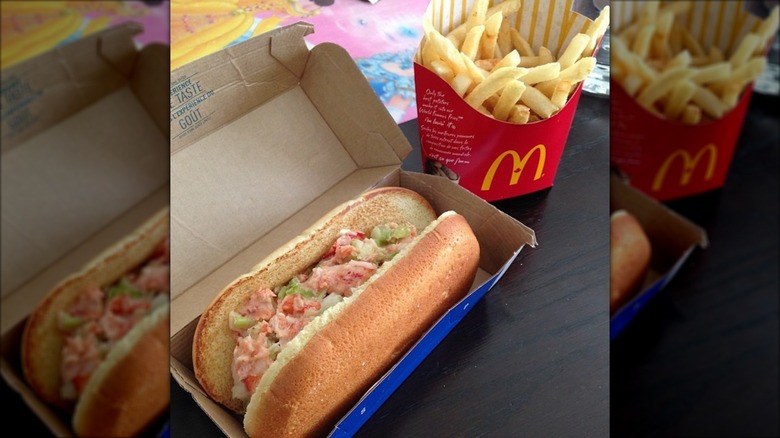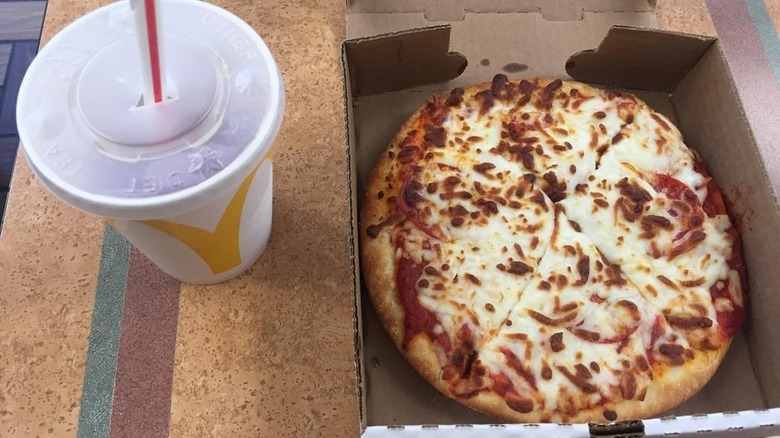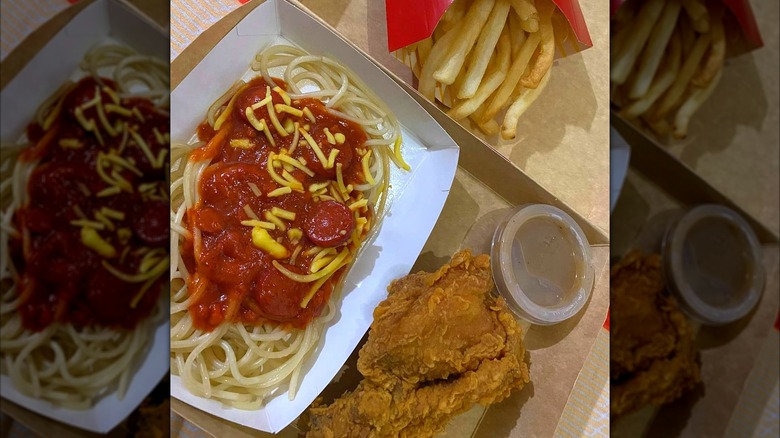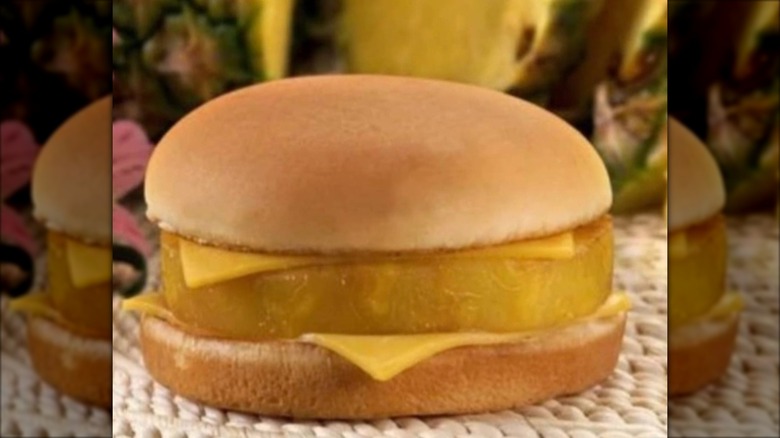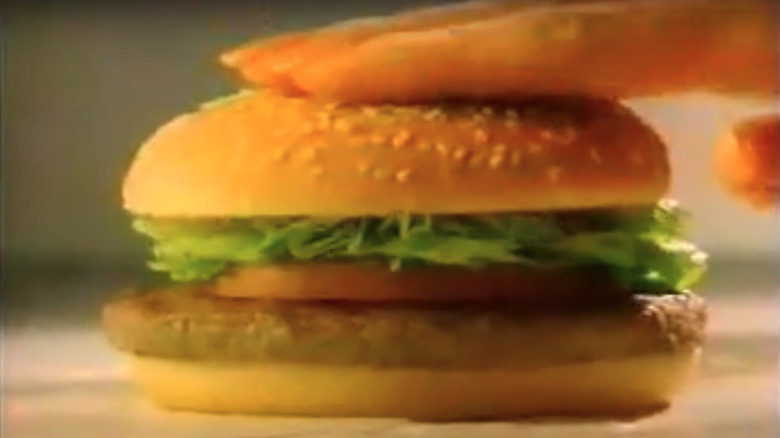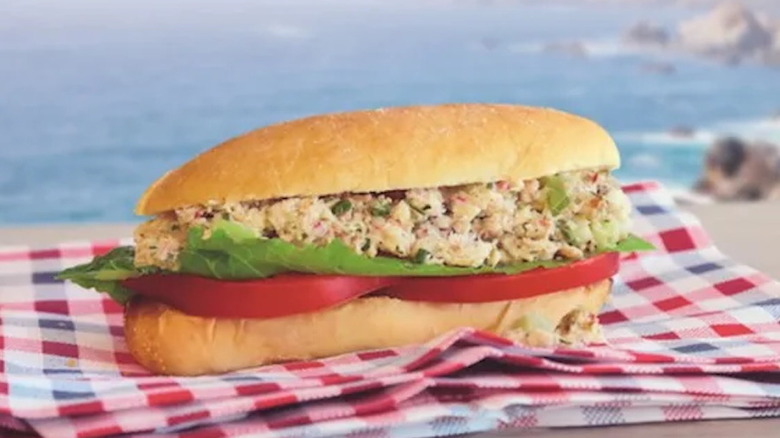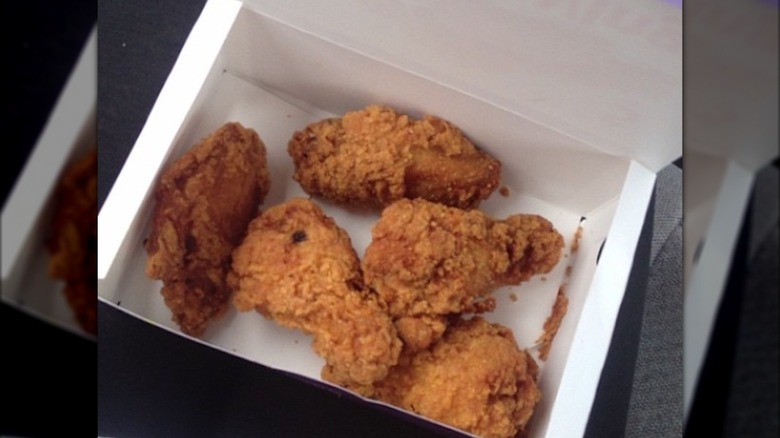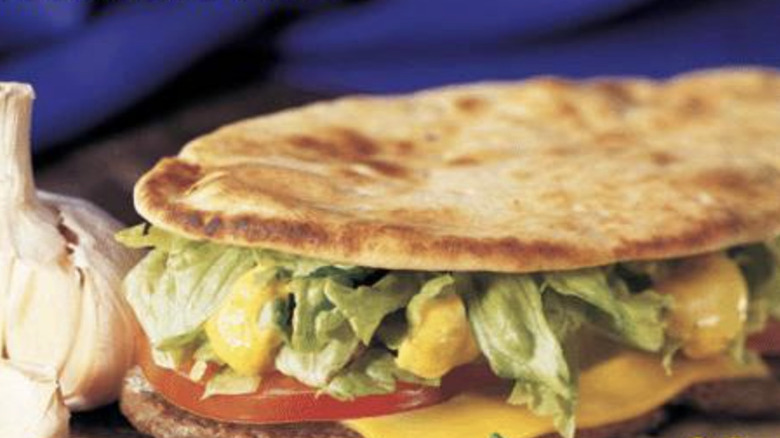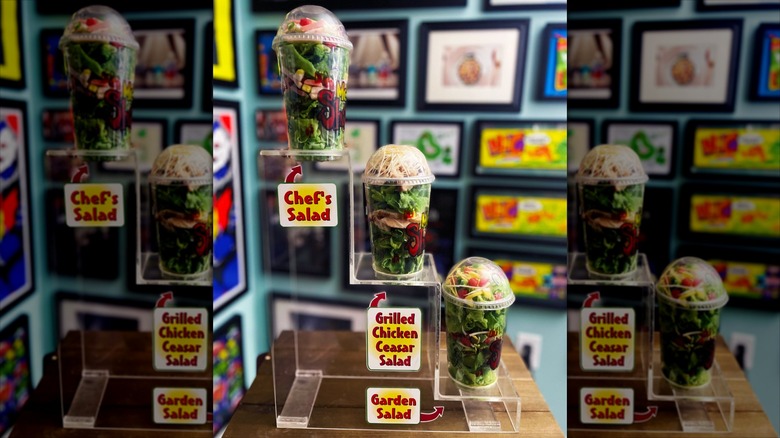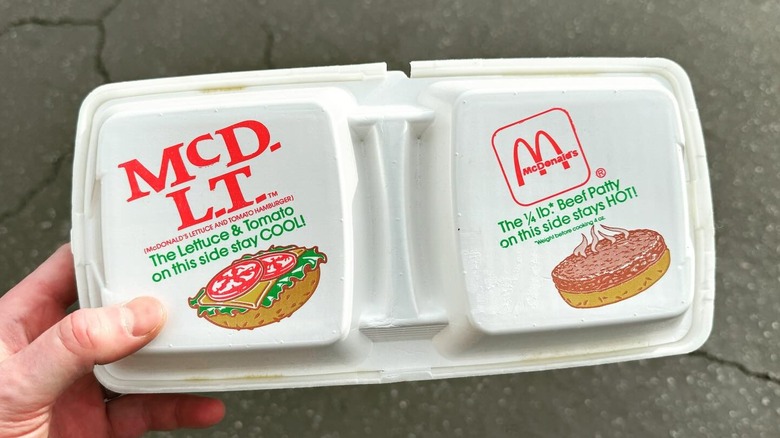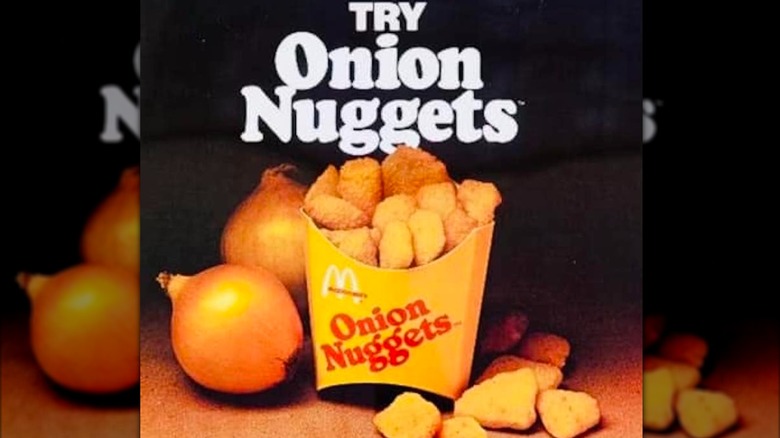From The McLobster To Onion Nuggets: 12 McDonald's Menu Items That Failed
With their iconic golden arches, McDonald's is not only one of the world's most successful fast food chains but a cultural staple. In 2025, the chain was named "the world's most valuable restaurant brand" by Brand Finance. And it's easy to see why. The chain boasts numerous iconic menu items, from their classic french fries to their indulgent Big Mac. But even a fast food giant like McDonald's hasn't been able to make every menu item a hit.
Over the years, McDonald's has launched a variety of new items that failed — ones that not even the most clever McDonald's menu hacks could save. So get ready for a dose of nostalgia and a trip down memory lane as we revisit 12 McDonald's menu items that missed the mark in capturing the public's affection.
McLobster
If you're heading to McDonald's, your taste buds probably aren't yearning for a lobster dinner. But in the 1990s, the popular fast food chain attempted to enter the world of seafood. In 1993, they launched the McLobster, which was their take on a classic lobster roll.
You may be wondering how McDonald's managed to offer this menu item for just $5.99 given lobster's heavy price tag. While some speculated that the chain was using fake lobster meat, it was indeed real — though not quite the kind most customers may be accustomed to. The McLobster was made using "CKL" meat, standing for claw, knuckle and leg, which is less desirable than the more coveted lobster tail.
Still, many customers weren't too pleased with having to pay $5.99 for the menu item, especially when a Big Mac cost $2.45 at the time. Unsurprisingly, the McLobster ultimately failed and quickly disappeared from menus nationwide. Since then, it has made occasional returns in New England and Canada, with the last revival occurring in 2017. If you're craving a lobster roll, you're probably better off making one yourself — it's likely to be a tastier choice.
McHotdog
Given McDonald's success with their iconic Big Mac and other burger offerings, introducing hot dogs to their menu seemed like a natural next step. However, McDonald's founder Ray Kroc wasn't on board. In his autobiography, "Grinding It Out: The Making of McDonald's," he explained that because you can't tell what's in a hot dog, the chain's quality check would never permit the item to be sold. Kroc's deep opposition to selling hot dogs at McDonald's prompted him to impose a lifetime ban, ensuring he would never see it appear on their menu.
But that didn't stop McDonald's from eventually introducing the McHotdog after his passing. Nearly a decade after Kroc died in 1984, the item was launched. It quickly flopped, despite years of planning. Perhaps hot dog lovers weren't too enthusiastic about giving up the fun of grilling their favorite hot dog brand at a classic backyard barbecue for the convenience of a quick meal at a drive-thru. While the McHotdog can still be found in Japan, it has all but disappeared practically everywhere else in the world. If Kroc were still alive, he'd likely be saying: "Told you so."
McPizza
Fast food chains are known for their speed. After all, "fast" is right there in the name. But when McDonald's decided to venture into Italian cuisine with the McPizza in 1989, they quickly discovered pizza and drive-thrus don't exactly mesh. The chain ran into several logistical hurdles during the development of this failed menu item. For starters, cooking an entire pizza isn't the type of thing you can do in the few minutes it takes for a customer to drive from the first drive-thru window to the next. In fact, the McPizza cook time lasted 11 to 16 minutes.
Timing wasn't the only issue. Drive-thru windows simply aren't built big enough to fit an entire box of pizza. In order to accommodate the new addition to their menu, McDonald's went as far as to widen some of their drive-thru windows to ensure customers could still order the item if they were on-the-go.
Despite their efforts, the McPizza all but disappeared by 2000. If you're still looking to try it, however, you can head to the largest McDonald's in the world — which is located in Orlando, Florida — where the McPizza is still offered.
McSpaghetti
Perhaps McDonald's should stay away from Italian food and stick to burgers and fries. The 1980s seemed to be the decade the chain tried to break into the market of Italian cuisine. Spoiler alert: It didn't work out so well. But not for the reason you may think. While spaghetti from McDonald's sounds slightly terrifying, the company reported the menu item was being accepted by customers. Rather, the issue that led to the McSpaghetti's downfall was the corporation's ability to keep up with the supply for the item.
The McSpaghetti was just one of the several pasta options McDonald's attempted to launch. The fast food giant also added fettuccine alfredo and lasagna to their menu during this era. Unsurprisingly, all of these items are pretty much nowhere to be found these days.
While this all-but-forgotten ex-menu item didn't find success in the United States — aside from that one huge McDonald's location in Orlando, Florida — one country still offers the item. The McSpaghetti can still be found on the menus of McDonald's locations in the Philippines, where it is sold as a part of one of their chicken platters.
Hula Burger
"I'll have a cheeseburger, except replace the hamburger patty with a slab of pineapple," said no one. Ever. Well, except maybe McDonald's founder Ray Kroc. In the 1960s, Kroc was on the hunt for a new menu item to make up for the drop in sales among Catholic customers avoiding meat on Fridays and during Lent. His solution? The Hula Burger, which consisted of a piece of grilled pineapple and cheese sandwiched between two pieces of bread.
But not everyone shared Kroc's vision. McDonald's franchise owner Lou Groen had a more traditional idea: the Filet-O-Fish. When Groen pitched the now-iconic fish sandwich, Kroc wasn't convinced. Determined to put both creations to the test, he proposed a deal where McDonald's would sell the Hula Burger and the Filet-O-Fish exclusively on Good Friday to see which one customers truly preferred. The item that made the most sales would win and claim a permanent spot on the menu.
Let's just say the results didn't exactly swing in Kroc's favor. The Filet-O-Fish absolutely swept in sales that day, with 350 sandwiches being sold. The Hula Burger managed a measly six. Yes, you read that right. Rather unsurprisingly, only six of the fruity sandwiches were sold. Those half-dozen customers may not have realized it at the time, but they were about to become a part of an exclusive club of McDonald's customers to experience one of the chain's biggest flops. Whether they actually enjoyed it remains a mystery.
McLean Deluxe
McDonald's may not be the first place that comes to mind when you're trying to eat healthier. But in 1991, the fast food giant decided to introduce the McLean Deluxe — the chain's attempt at a burger for the health-conscious customer.
Advertisements for the McLean Deluxe leaned into its lower fat content, boasting that the burger was 91% fat-free. Although this may be true (a typical Big Mac contained 26 grams of fat while the McLean Deluxe had just 10 grams), the burger's high sodium level still prevented it from being considered healthy. Still, McDonald's leaned into the marketing angle as much as possible. To decrease the amount of fat, McDonald's replaced some of it with carrageenan, a food thickener that is derived from red seaweed. But the seaweed additive not only removed calories but flavor, and the McLean Deluxe quickly garnered a reputation for being bland.
By 1996, the McLean Deluxe was nowhere to be found on the McDonald's menu. Maybe that's because it was ahead of its time. With today's obsession with plant-based alternatives and superfood supplements, a seaweed-infused burger doesn't sound too out of the ordinary in 2025. Though you'd probably be more likely to spot one on the shelves of Erewhon in Los Angeles before it made a comeback at this fast food chain.
Crab Meat Sandwich
Crab has had a long (and unsuccessful) history with the Golden Arches. The first crab-related item the chain launched was a Crab Cake Sandwich in 1992. Reviews of the dish weren't bad — they were brutal. A Baltimore Sun headline referred to the sandwich as "More cake than crab," only complimenting the dish for being "fast" and "cheap." Ouch. It was hardly the kind of endorsement that would have customers rushing to their nearest McDonald's to order one. And they didn't.
After its removal from the menu, the Crab Cake Sandwich returned to the menu as the McCrab in 2003. Maybe McDonald's thought adding a "Mc" to the beginning of it would make it a hit? It didn't. The McCrab became yet another failure for the chain as it didn't prove to be competitive enough in the crab cake market.
But it seems the chain wasn't ready to give up as they launched yet another crab menu item in 2017 under a new name: the Crab Meat Sandwich. But the third time wasn't a charm. The name change did nothing for sales and the sandwich flopped (yet again), proving that when it comes to seafood, perhaps this fast food chain should just stick to their Filet-O-Fish.
Mighty Wings
From Chicken McNuggets to the McChicken, McDonald's has found great success in the world of chicken. But not every addition to their menu has been a winner, such as the Mighty Wings which initially launched in 1990.
Unlike many other menu items on today's list, these chicken wings didn't tank because of what was inside the box but because of the high price tag attached to it. Mighty Wings were sold in boxes of three, five, and 10 which were priced at $3.19, $4.99, and $8.99, respectively. At a chain where you can buy an entire meal for just $5, it's no wonder that customers weren't drawn to drop nearly double that on a box of chicken wings.
While the item vanished by 2003, it returned to menus a decade later. But with the return of the Mighty Wings came the return of those steep prices, as the chain continued to sell their five-wing box at $4.99. The menu item proved to be so unpopular among McDonald's customer base that the chain was left with 10 million pounds of unsold chicken wings. In order to avoid a complete loss, Mighty Wings were sold at just $3 for a five-wing box the following summer. Although slashing prices attracted customers, it resulted in a painful financial loss for the corporation. After this disastrous revival, it's unlikely the Mighty Wings will return once more.
McAfrika
While some failed menu items were offensive to customers' taste buds, this next one was offensive on several levels. In 2002, McDonald's launched the McAfrika in Norway in honor of the Winter Olympics. The sandwich was a take on a cheeseburger except served in a pita bread bun instead of your typical hamburger roll.
The problem? Although McDonald's claimed it was a nod to the sandwich's African origins, their timing couldn't have been worse as a severe famine had left 12 million people across South Africa starving at the time. The insensitivity of the launch of the McAfrika immediately brought on public backlash. Rather than pulling the item from the menu or directly donating the proceeds to famine relief, McDonald's opted for a puzzling solution. The chain chose to place donation boxes at participating locations, shifting their responsibility to their customers and encouraging them to contribute to the cause in the most half-hearted way possible.
And it seems the chain didn't learn their lesson the first time around because in 2008 they brought the burger back under an ever-so-slightly modified name: the "McAfrica." This iteration featured different ingredients, swapping the pita bread for a regular hamburger bun and adding on an "exotic African sauce." If the chain thought a new sauce and changing one letter would undo the previous PR disaster six years prior, they thought wrong as the item failed yet again.
McSalad Shakers
Sometimes innovation goes unrewarded. In 2000, McSalad Shakers hit the scene. The concept was simple: Get your cup of salad, add dressing, shake it up, and enjoy. This salad-in-a-cup was the perfect lunch option for the customer on-the-go and came in three variations: chef salad, grilled chicken caesar salad, and garden salad.
While it was certainly a creative take on a fast food salad, unfortunately, the McDonald's customer base didn't fall in love with the creation. The chain eventually replaced the portable leafy greens with a more classic salad served in a bowl.
Unlike other failed menu items, this one left a small but devoted fanbase behind, with Reddit users calling on the chain to bring back the salad concoction. While McDonald's hasn't made any indication of fulfilling their wishes, they referenced the menu item in an April 2023 X post stating, "my grandma got a twitter just to tell me to bring back mcsalad shakers." Who knows, it might just be the hope McSalad Shaker stans need that the item may one day return.
McDLT
While the McDLT featured a burger with pretty standard toppings, including lettuce, tomato, and pickles, what set it apart (for better and for worse) was its packaging. Rather than serving customers a constructed burger, McDonald's delivered the McDLT deconstructed with one half of the container holding the cold lettuce and tomato and the other half holding the hot hamburger.
The idea was to keep the cold ingredients cold and the hot ingredients hot until it was time to eat. While it might've been a clever way to achieve a fresher burger, it's not surprising the item failed. Fast food chains are most ideal for those in a hurry. Customers go to McDonald's for a quick bite, not a build-your-own-burger experience.
Although the packaging of the burger seems a bit illogical, that wasn't the reason the McDLT failed. Its real downfall came from the use of styrofoam in the packaging. Styrofoam, which is notoriously harmful to the environment, can take hundreds of years to break down. As public concern and pushback arose, McDonald's tried to pivot. The company, which went as far as to patent the McDLT's unique packaging, attempted to shift to a more environmentally friendly box made out of paper or cardboard ... but eventually gave up. Without the signature styrofoam container keeping the hot and cold ingredients separate, the burger lost its defining feature. McDonald's ultimately pulled the McDLT from their menu.
Onion Nuggets
Move over onion rings, there's a new kid in town — or at least McDonald's hoped there would be. Before their highly popular Chicken McNuggets were born, in 1975 the Golden Arches had another nugget on the brain: Onion Nuggets.
Instead of batter-coated, deep-fried chicken, McDonald's chefs whipped up chunks of onion in that same crispy coating. It seems the appeal didn't translate even to those who don't mind a little onion.
If you've never heard of Onion Nuggets that's because they didn't stick around for long. McDonald's chairman Fred Turner advised replacing the onions with chicken and the rest was history. Unlike many other failed menu items that have made unexpected (and undesired) comebacks, Onion Nuggets have remained in the past. In fact, McDonald's hasn't sold any primarily onion-based product, avoiding even the hugely popular onion rings.
Why the chain didn't apply the same restraint when it came to food items like crab, or menu items that were controversial such as the McAfrika (seriously, who is deciding these failed item comebacks?), the world may never know. As for the future of Onion Nuggets? It's safe to say McDonald's doesn't seem likely to give them a triumphant return anytime soon.

